
Background Top
Flipping is an art. Countless novices attempt to improve their technique everyday through rigorous trial and error. In order to perform a clean executed flip, it takes a seasoned veteran; that of the caliber of Cameron Stahl. Our project is intended to determine the differences in the rotational speeds of a front flip relative to a back flip. The term for the use of energy in this situation is called the “conservation of angular momentum.” The basic concept is that as an object spins around a general point, the shorter the radius (distance between end of object and set point), the faster the object rotates. We all deal with this law everyday and it affects gymnasts immensely in everything they do.
A common example of this effect is an ice skater spinning on the ice. As he or she is spinning with a leg kicked out and arms flailing, his/her speed is much slower than when he/she pulls everything in and tucks down into the ice. Everyone can imagine how the skater would speed up significantly as they become a small ball spinning rapidly on the ice, and then slow down again as they unfold and stand up.
Question Top
Which flip has a faster rotational speed?
Why?
Hypothesis Top
If Cameron completes both a front flip and a back flip, then the front flip will have a faster overall rotational speed because Cameron tucks faster during a front flip (because it’s lower and therefore doesn’t allow for as much time to rotate as the back flip does).
Method (To the Madness) Top
For our experiment, we used LoggerPro to analyze video of a trained gymnast performing back flips and front flips. These trials took place on the flat competition floor in Metro Gymnastics Center. The camera used for the video was set on a flat surface 26 meters away from the gymnast (in order to flatten the viewing plane). In addition, we set a box in the same plane as the gymnast with known dimensions (0.762meters) in order to calibrate the video during analysis. We then filmed ten separate trials of each of the respective flips to acquire an adequate data set. Utilizing the frame by frame feature, we counted the number of frames that the gymnast was airborne. We then took that number and plugged it into the following equation:

This equation allowed us to compare the front flip to the back flip. We also graphed the angle of the gymnast’s body with respect to time using LoggerPro.
This
was done in order to more accurately show why one flip was faster
than the other. We marked his shoulder and his hip and used the line
between them to more accurately determine the angle of his body. We
utilized these markings to figure out how the angle of the gymnast’s
body changes over time (using a protractor).
Materials Used:
High Definition Camera
Calculator
Computer
LoggerPro
Tape (for marking)
Protractor
Results for Back Flips Top
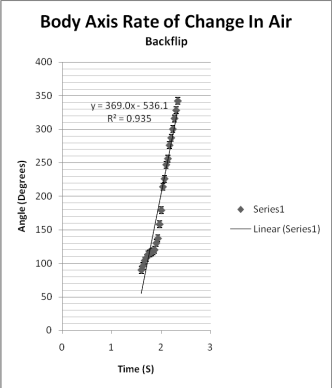
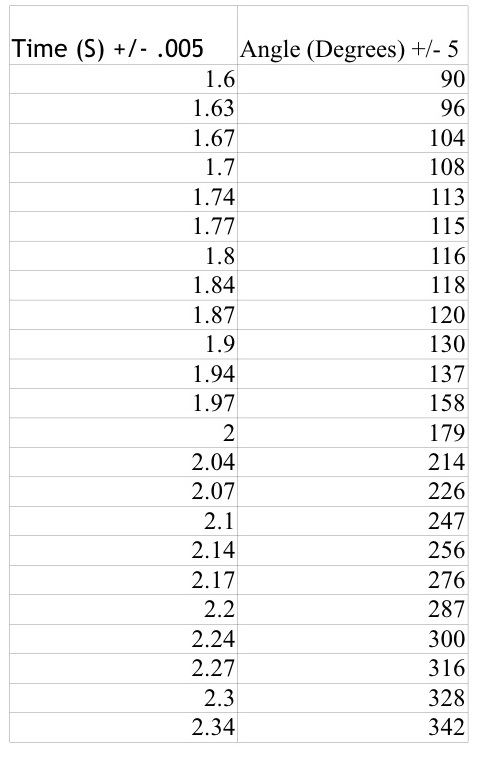
Results for Front Flips Top
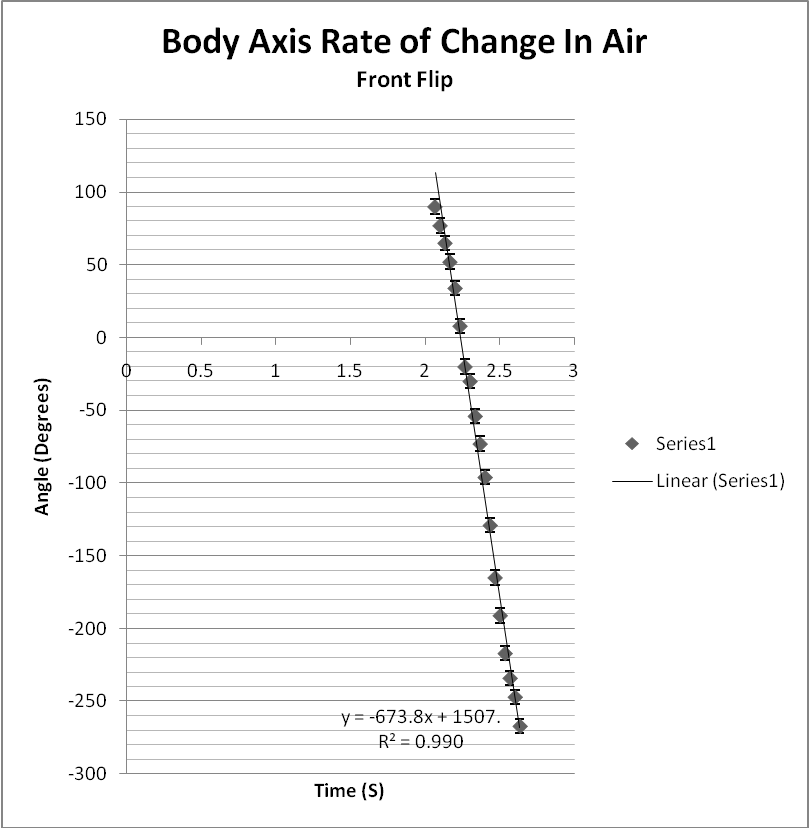
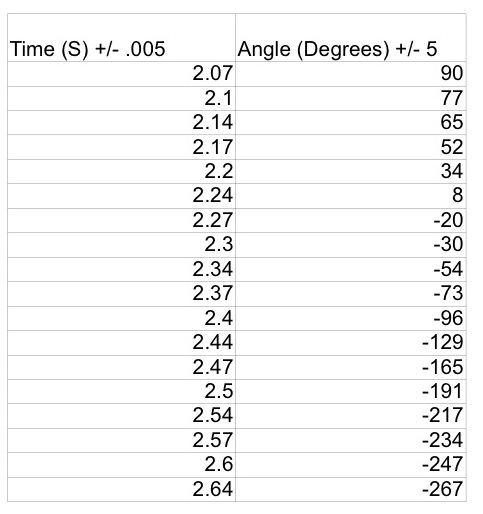
Summary of Results Top
Through testing, we discovered that the overall speed of the gymnast’s front flip is faster than the overall speed of his back flip. Despite the faster rotational speed of his front flip, his feet attain a faster overall velocity during a back flip. This could be because the front flip’s faster overall speed has to do with the rotational moment of inertia, or the compact body position that the gymnast retains throughout the front flip relative to the back flip. Because his body was in a more open body position (feet farther away from his center of gravity) his feet have to travel a greater distance while still rotating the same distance. In the front flip his feet stayed closer to his body making the flip itself faster, but the velocity of his feet was less because hey have less distance to travel.
Back Flip
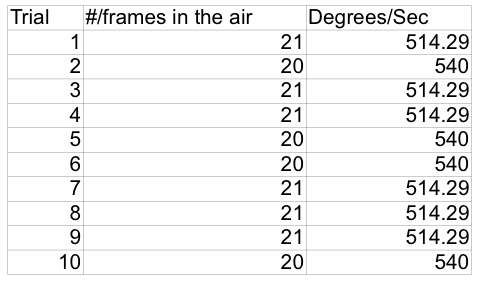
Front Flip
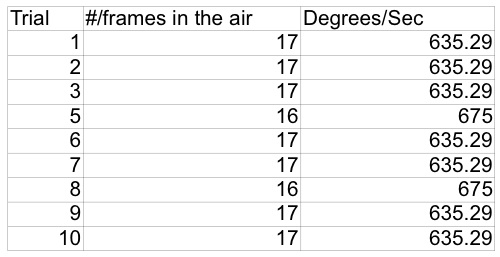
Conclusion Top
After analyzing the data with LoggerPro, we found that our hypothesis was supported. The gymnast’s front flip rotates faster than his back flip. Out of ten front flip trials, the average velocity in degrees/second was 647.2, and the average back flip velocity was 524.6.
In addition to the table, our graphs show that the gymnast accelerated slowly in the beginning of the back flip and then sped up after tucking his extremities closer to his center of gravity. The graph of the front flips, however, illustrates an almost uniform linear relationship throughout the front flip. The front flip was faster because the gymnast threw his body forward and tucked harder going forwards rather than backwards. In a back flip, the tuck is initiated much later. We also noticed that the back flip was more or less a two step process; first you jump vertically, and then you throw your hips over your head. The front flip, on the other hand, was a smoother maneuver preformed in one step. This allowed the gymnast to utilize his rotational moment of inertia more effectively, because an object with its mass spread out resists rotation more easily than an object with its mass concentrated in a smaller area.


Our experiment involved a substantial amount of error. Some of the error included: identifying which frames the gymnast was airborne, measuring the angle of the gymnast during rotation, the placement and stability of the camera, and flipping consistency. Ways to improve our experiment involve; better video analysis software (it’s alright Murray you did the best you could), a stable tripod, an in-computer protractor (to reduce human error), and a larger quantity of trials.
Links to Youtube videos:Top
.:.Download the original videos.:.
http://www.youtube.com/watch?v=l_VRXOtjt5I:
http://www.youtube.com/watch?v=_Z_C5OdSlig
http://www.youtube.com/watch?v=4xAHxrt_nv0
http://www.youtube.com/watch?v=AxtwXrQDruI
Graphs and tables (Excel): Top
Backflip Time vs. Angle spreadsheet
Backflip Body Axis Rate Of Change graph
Front flip Time vs. Angle spreadsheet
Front flip Body Axis Rate Of Change graph
Sources: Top
www.csepio.phys.utk.edu/astr161/lect/solarsus/angmom.html- angular momentum simulations
www.en.wikipedia.org/wiki/angular_momuntum- general information about angular momentum
www.youtube.com/watch?v=ucXgKSDB25o- video showing other instances of angular momentum
www.metrogymnastics.com/boys-team-gymnastics.html - Luke Cartmill (Gymnastics Instructor)
www.lightandmatter.com/html_books/2cl/ch05/ch05.html- online textbook that goes over angular momentum in greater detail